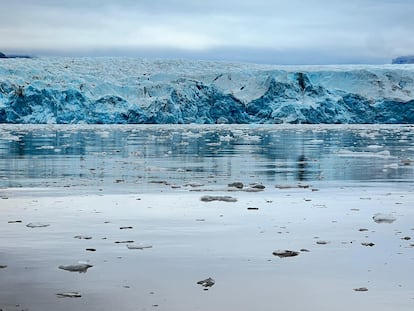Where will the tourists go? Europe’s winning and losing destinations due to the climate crisis
Analysis by European Commission experts places parts of Spain among those regions where the number of overnight stays will fall the most with the advance of global warming. Cyprus and Greece will suffer the largest drop


Idyllic holiday destinations can become a true hell like that which various Greek islands and Sicily have experienced this summer due to wildfires, or extreme heat waves, such as the four that have hit many parts of Spain this summer. Both phenomena are part of the catalog of disasters linked to human-induced climate change that stems from our dependence on fossil fuels. The climate crisis threatens people’s health and national economies. And in the case of tourism, where Europe’s position is at stake — it is the most-visited region on the planet whose tourist sector moves around €2 trillion ($2.171 trillion) each year — the forecasts point to significant impacts and a reduction in visitors to some areas as global warming progresses. But will the damage be the same throughout Europe? No. There will be winners and losers, and the south of the continent has the worst prognosis, according to analysis undertaken by the Joint Research Centre (JRC), scientific advisors to the European Commission.
“EU policy aims to maintain Europe’s status as a leading tourist destination,” explains the report, which includes work by Spanish analysts David García-León and Juan Carlos Ciscar. The JRC study, entitled Regional impact of climate change on European tourism demand, seeks to provide an approximation of how visits to different destinations may change depending on the level of warming that occurs. In all of the scenarios, eight Spanish regions are among the most affected by the reduction in the number of overnight stays: the Balearic Islands, Murcia, the Valencia region, Extremadura, Andalusia, the Madrid region, Castilla-La Mancha, and Catalonia. In addition, Spain will be the European country that will lose the most visitors, after Cyprus, Greece, and Portugal.
Global warming is already hovering around 1.2º Celsius. This means that the average surface temperature of the entire planet is 1.2º C warmer than in the pre-industrial era — before humans became dependent on burning fossil fuels for energy, and greenhouse gas emissions skyrocketed. As long as the world economy depends on the fuels causing these emissions, warming will continue to increase, as gases accumulate in the atmosphere and remain there for decades or even centuries. In its study, the JRC proposes four scenarios for temperature increases: two that are optimistic (warming remains at 1.5º C or 2º C) and two that are pessimistic (warming reaches 3ºC or 4ºC).
In the eight Spanish regions mentioned, reductions in overnight stays are forecast in all of the four scenarios that were analysed. Although the situation is complicated in the case of a temperature increase of 3º C and 4º C. The Balearic Islands, for example, would lose up to 8.16% of overnight stays if there was an increase of 4º C, while the reduction in Murcia would be 6.8%, and 3.2% in the Valencia region. For this analysis, the JRC experts took 2019 tourism data as a base, which is the most similar to current data, after several years of negative impact from the Covid-19 pandemic.
The Greek region of the Ionian Islands — severely hit by wildfires this summer — would be the most affected by this four-degree warming scenario, with a 9.1% reduction in overnight stays. It is followed by the Greek islands in the North Aegean Sea (-9%), those in the South Aegean (-8.6%), and Cyprus (-8.2%). In fifth and seventh places, respectively, are the Balearic Islands and the Region of Murcia in Spain.
The study analyzed the effects in 267 European regions. In 50 — located further south on the continent — tourist losses are forecast in a scenario of 4º C of warming. At the opposite extreme, considerable increases of over 5% in overnight stays are anticipated in 53 regions. The region that would benefit most is West Wales, in the United Kingdom, where there would be increases of almost 16%.
“We found a clear north-south pattern in changes in tourism demand, with northern regions benefiting from climate change and southern regions facing significant reductions,” the report explains. “This pattern is more acute for scenarios of higher levels of warming,” it adds.
To carry out their analysis, the JRC experts drew up a historical evaluation that estimated the statistical relationship between overnight stays, the so-called tourist climate index (which focuses on comfort linked to weather conditions) and other economic variables. The type of destination is also taken into account, whether it is urban, coastal, rural, winter mountain, or mixed. And based on these data, they forecast how the tourist demand will evolve for months and the variations in overnight stays.
Fulfilling the Paris Agreement
In terms of the monthly demand, changes are expected in “tourism seasonality patterns.” “Northern European coastal regions are expected to register a significant increase in demand during the summer and early autumn months, while southern coastal regions are expected to lose tourists during the summer, especially in the more severe climate scenarios,” the scientists explain. Regarding tourism demand in general, the climate impact is positive in all warming scenarios, with a projected increase in demand in the whole of Europe of between 0.35% and 1.58% depending on the scenario. “But the aggregate results hide a high degree of heterogeneity between regions,” warn the authors of the report, which points to this north-south difference.
By country, Cyprus (with a reduction of up to 8.28% in tourist demand in the worst warming scenario) is hit the hardest. It is followed by Greece (-7.26%), Portugal (-3.31%) and Spain, with a fall of 3.14% if warming reaches 4º C.
But within Spain the situation also varies. And there will also be winners and losers. The regions that benefited most from the increase in overnight stays are Cantabria, Asturias, and Galicia. If warming reaches 4º C, the tourist demand would increase by 7.2%, 4.2%, and 3.1% respectively in these regions.
But that is the worst case scenario, and would mean a breach of the Paris Agreement. The climate treaty signed in 2015 forces the signatory countries to reduce their greenhouse gas emissions to almost zero from the second half of the century. This pact establishes the goal of keeping warming below 2º C and, as far as possible, below 1.5º C. That is the safety limit that scientists have set. Complying with what was agreed in Paris would also be good news for the Spanish tourism sector. In the scenario of an increase of only 1.5º C, the JRC study predicts a reduction of only 0.31% in tourist demand in Spain; with an increase of 2º C, the decrease would be 0.4%, far from the 3.14% expected if it reaches 4º C.
Sign up for our weekly newsletter to get more English-language news coverage from EL PAÍS USA Edition
Tu suscripción se está usando en otro dispositivo
¿Quieres añadir otro usuario a tu suscripción?
Si continúas leyendo en este dispositivo, no se podrá leer en el otro.
FlechaTu suscripción se está usando en otro dispositivo y solo puedes acceder a EL PAÍS desde un dispositivo a la vez.
Si quieres compartir tu cuenta, cambia tu suscripción a la modalidad Premium, así podrás añadir otro usuario. Cada uno accederá con su propia cuenta de email, lo que os permitirá personalizar vuestra experiencia en EL PAÍS.
¿Tienes una suscripción de empresa? Accede aquí para contratar más cuentas.
En el caso de no saber quién está usando tu cuenta, te recomendamos cambiar tu contraseña aquí.
Si decides continuar compartiendo tu cuenta, este mensaje se mostrará en tu dispositivo y en el de la otra persona que está usando tu cuenta de forma indefinida, afectando a tu experiencia de lectura. Puedes consultar aquí los términos y condiciones de la suscripción digital.
More information
Archived In
Últimas noticias
Welcome to the post-religion era: The idea of Christianity as the absolute truth has become obsolete
‘I thought you would like it’: The risky sexual practice popularized by TV shows and TikTok
The digitalization of tourism: ‘They promise experiences and gave us the worst possible one’
Mexican peso defies uncertainty with forecasts of a new period of stability in 2026
Most viewed
- Sinaloa Cartel war is taking its toll on Los Chapitos
- Reinhard Genzel, Nobel laureate in physics: ‘One-minute videos will never give you the truth’
- Oona Chaplin: ‘I told James Cameron that I was living in a treehouse and starting a permaculture project with a friend’
- Why the price of coffee has skyrocketed: from Brazilian plantations to specialty coffee houses
- Silver prices are going crazy: This is what’s fueling the rally










































